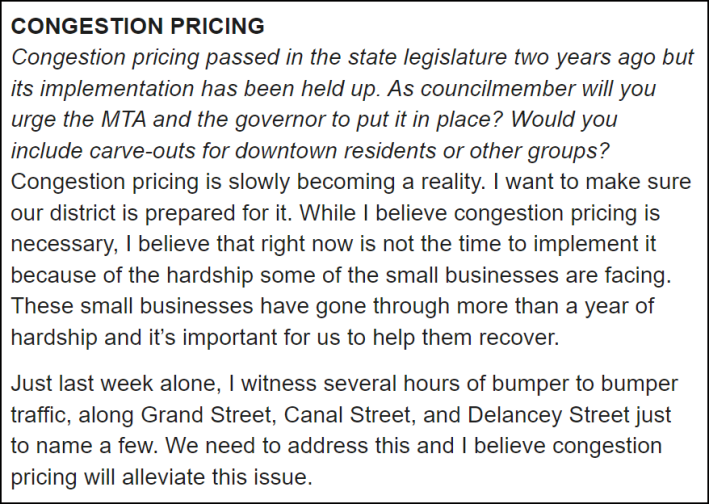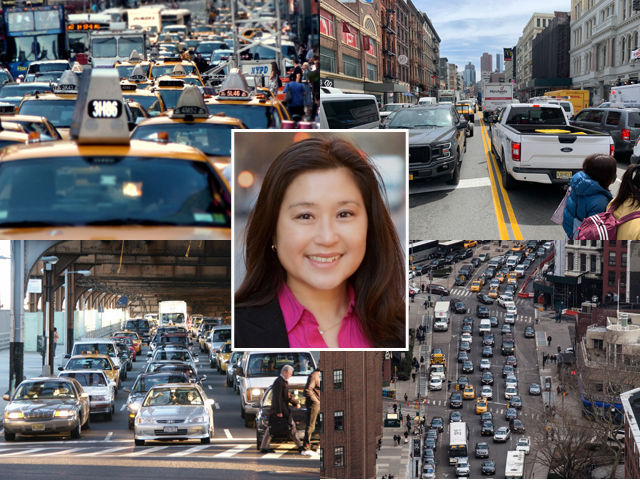So much for personal diplomacy.
During the last municipal election year, 2021, I spent an afternoon with Council candidate Susan Lee, explaining why our Lower Manhattan district, District 1, stood to be the biggest beneficiary of congestion pricing among the 51 districts:
- The number of vehicles pouring into the district via the Brooklyn, Manhattan and Williamsburg Bridges would drop by 20 to 25 percent, with the reduction rising to 35 percent as the congestion revenues transmuted into better subway service.
- Fewer trucks would drive in from Brooklyn and clog Varick, Broome, Canal and other downtown “traffic sewers” feeding the Holland Tunnel.
- The drop in cars would touch off a boom in biking and walking.
- Council District 1 has not just the congestion zone’s but all of New York City’s greatest density of subway stations and lines.
- And, just maybe, fewer apparatchiks would drive to work in their personal cars as changing currents unleashed by congestion pricing began to lap away at placard abuse.
Though Lee didn’t resoundingly endorse congestion pricing in her 2021 campaign, she sounded more for than against, at least in her extensive interview with hyperlocal news source Tribeca Citizen (printed in full in text box below).

Lee’s 2021 candidacy never caught fire, garnering less than 8 percent of the Democratic primary vote. She was outpolled 5 to 1 by eventual winner and now incumbent Council Member Christopher Marte, whose stance on congestion pricing is equally platitudinous: I’m for it, he says, provided residents get heavy toll discounts.
Now, Lee is running again, this time as an avowed congestion pricing opponent. Last week she penned an op-ed in the Daily News whose headline pairs “congestion pricing” with “hurt” and “suffer.” You get the idea.
Lee’s essay dredges up the classic negatives — “medical appointments,” “senior citizens whose children would be dissuaded from visiting,” harming Chinatown businesses by “limiting the number of visitors through a costly pricing mechanism.”
Yes, congestion pricing will dissuade some car trips to Chinatown or other District 1 neighborhoods while extracting revenues from the trips that continue to be made. Those costs are real, and they’re included in the ledgers I shared with Lee in 2021. Alas, of congestion pricing’s many, more-than-offsetting positives, Lee has nary a thing to say. Cleaner air, especially around the three East River bridges that dump cars and trucks into Chinatown and the Lower East Side? Nada. Calmer streets all over downtown? Nada. Unstuck buses? Nada. Better subways? Nada. It’s all fear. All downsides, no upsides. (Broader issues of transportation and transit are not mentioned on Lee's campaign website at all.)
Ever the optimist, I can’t help wondering if Lee would have enhanced her candidacy by backing congestion pricing to the hilt. “Congestion Pricing Can’t Come Soon Enough for Downtown Council Candidate Lee,” one of lower Manhattan’s numerous news outlets might have written. Or “Susan Lee: Congestion Pricing Will Make Life Easier and More Healthful for Downtown Residents.”
That kind of bold, clear stance might have juiced her campaign, perhaps designating her a “profile in courage,” making voters wonder about Marte’s resolve, and signaling Lee’s readiness to come out swinging for other causes that are making downtown residents increasingly vocal — more housing and fewer helicopter flights, to name a few.
Instead, Lee is mired in the usual, tired canards. These three from her op-ed particularly rankle (italicized passages are quotes):
- Using price is a means of social control. Goodness. Like it or not, prices propel choices, and a century of failure to “price in” the enormous negatives caused by downtown driving has created its own social control: destructive gridlock, pollution and fear.
- The cost will fall most heavily on those least able to pay, whether they live outside the zone and drive in for medical appointments, or are low-income residents within the zone. It’s amazing that Lee, now a two-time aspirant for public office, is apparently unaware of the “central business district toll credit” portion of §606 of NY State Law, which provides residents of the zone earning less than $60,000 a state tax credit for their congestion tolls. (This provision has been noted in scores of press reports since its 2019 enactment as part of the congestion pricing package.) She has also evidently missed out on coverage of the MTA’s intent, announced this month, to grant toll discounts to any low-income New Yorker whose car trips into the zone exceed a monthly threshold.
- I am ready to work with all stakeholders to find a way to raise funds for the MTA to raise funds for the MTA, lower pollution levels in Manhattan and beyond, and protect the small business community that is a lifeline for neighborhoods such as mine. Congestion pricing is not that plan. With these anodyne words, candidate Lee nullifies 60 years of Nobel Prize-level economic theory underlying congestion pricing, decades of its successful application in Singapore, London and Stockholm, and the judgment of virtually every reputable transit-advocacy organization in New York City and the region that congestion pricing alone can fund better transit AND reduce ruinous traffic.
There is no other congestion-nullifying plan — if there were, Riders Alliance, Regional Plan Association, Tri-State Transportation Campaign, Gridlock Sam, yours truly and the legions of other congestion pricing proponents would be backing it instead.
Straddling the fence on congestion pricing — and that’s a charitable characterization of what Susan Lee is doing — is defeatist and deceitful at the same time. She didn’t have the bravery to say it, so we will: congestion pricing will make life easier and more healthful for Downtown residents. It can’t come soon enough.
The primary elections for the City Council are on Tuesday, June 27. Early voting begins on Saturday, June 17 and continues through Sunday, June 25. For info, visit the Board of Elections website.






